A lot of the tech that I test can seem like science fiction, but using it in the real world can be a chore. That’s how I feel about the Humane AI Pin. I can see a future idea in this clip-on thing that promises a living version of a Starfleet Badge, but that future isn’t here yet.
The Humane AI Pin ($699) wants to be a self-sufficient phone replacement, a shiny voice-controlled communicator that also throws out laser displays you can control with your hands, like a magically projected dashboard. It’s amazing in concept, but so frustrating in execution. Humane’s Pin could be the future of wearables beyond our watches, but right now it doesn’t have enough consistency or connectivity.
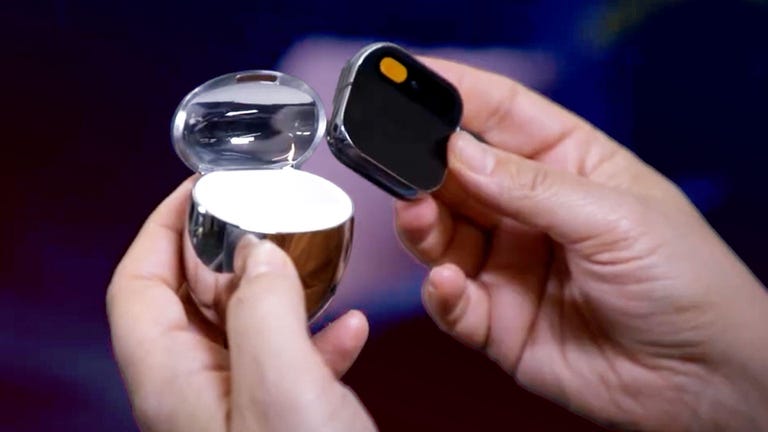
Watch this: Humane’s AI Pin: Unboxed and Tested
This also won’t be the last AI wearable we see: Meta’s Ray-Ban glasses already have AI capabilities rolling out to the public in the next month; startup Brilliant is making display-enabled AI glasses; and the Rabbit R1 is a handheld AI-powered gadget, like a phone-meets-AI GameBoy.
The AI Pin falls in the middle of these. Many of these devices are striving for a way to reinvent the phone in my pocket, but I’ve gotta say: that phone is already pretty damn versatile and amazing. It already has my interconnected life living on it. That’s what AI wearables need to contend with, much like smartwatches did before. They need to be helpful, affordable extensions and not expensive attempts at reinventing what already works.
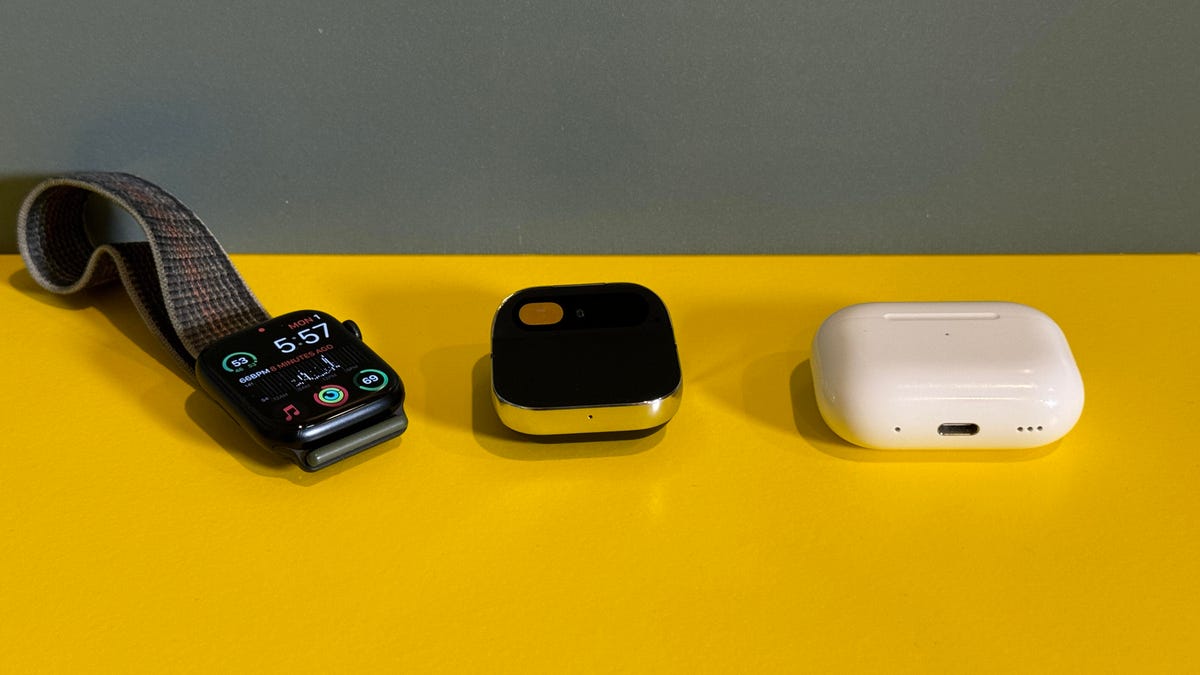
The Humane AI Pin between the Apple Watch and AirPods: it feels like a design cousin.
Little, shiny, eye-catching
The AI Pin is certainly nicely made. The brainchild of former Apple engineers and designers Imran Chaudhri and Bethany Bongiorno, it looks like a cross between the Apple Watch and AirPods, if both somehow fused to become a camera-enabled mini-pod. Smooth and metal-edged, it reminds me of the design of the first iPhone in miniature.
The accessories are well-conceived too. The AI Pin has its own battery onboard and also a battery-extending booster that magnetically clips on through clothing and keeps an extra charge passing through. I’ve never seen anything like that before.
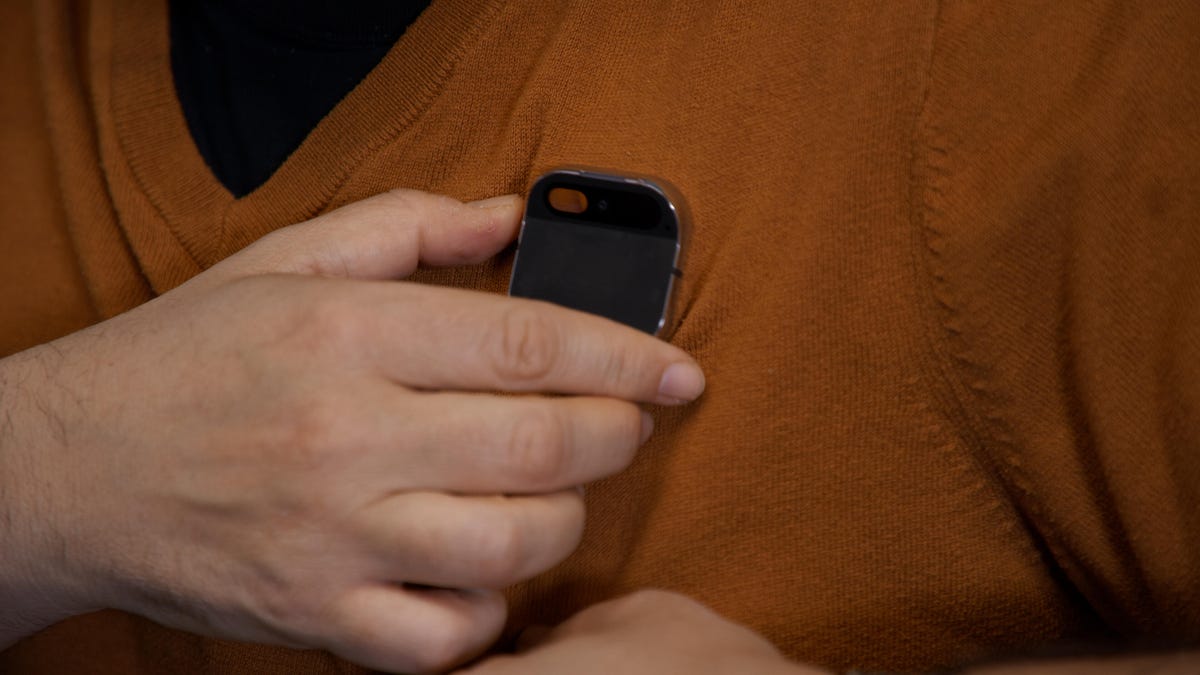
The AI Pin clips right to clothing magnetically, with a rear battery pack attaching and powering right through the cloth.
The AI Pin includes an extra battery pack, as well as two ways to charge up. One, a little charge cradle, lets you use the Pin’s voice-activated features while still charging on a desk. The other, a little egg-shaped portable charge pack, has its own battery and feels like the kind of AirPods case EVE from Wall-E would use. It can also charge those battery boost packs while the other one’s being worn.
This swappable battery system is one of the best ideas about the pin. I found my everyday battery life lasting most of a day, far longer than the few hours I get with Meta’s Ray-Ban glasses before needing to take them off for a charge (and then not have glasses). I like the comfort of consistent charge options.
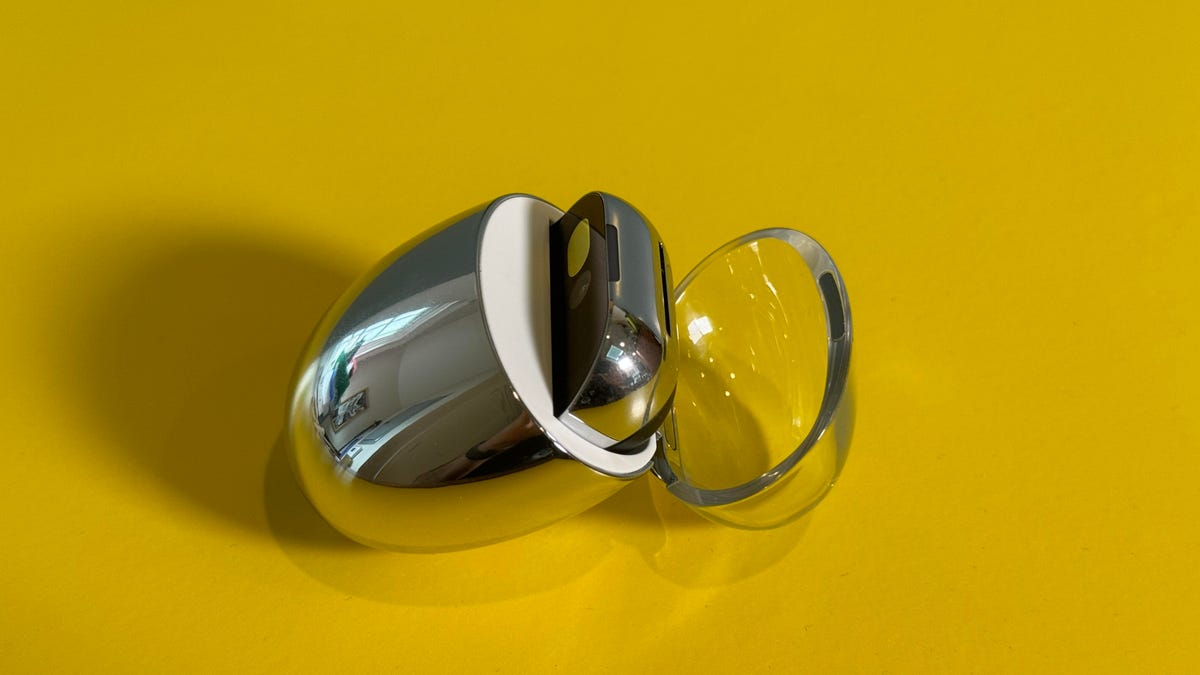
The little portable battery charger is adorable and helpful. Batteries can also be swapped out on the fly.
There are also a few extra clip types for different outfits. That battery booster is a bit bulky and feels weird under my sweater, for instance, but a thinner backing clip without a battery is made for thinner shirts. Then there’s a clip with a metal add-on for when the magnet system is too weak for thicker clothes or jackets.
The pin is button-free, relying on a touchpad on the front to tap and hold for voice commands. There’s no voice activation, which means you’ll always be tapping (literally, like a Star Trek officer): one finger tap for voice, two fingers held for translation, two fingers double-tapped to take photos and tap and hold to record a video. Note: It can record only 15 seconds of video at a time.
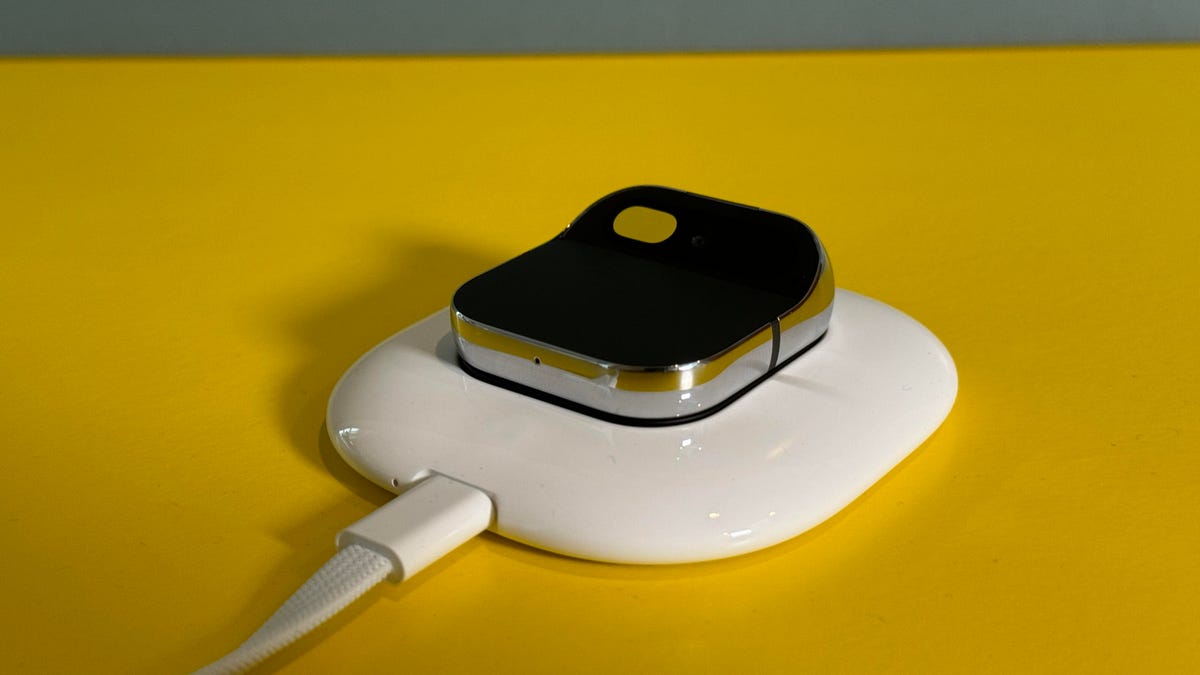
The charge base can let you keep it deskside and still use voice commands.
That wild projected laser with hand tracking: Amazing and frustrating
The AI Pin’s signature laser-projected magic trick interface happens when you tap the pin and hold your hand out. Near-range tracking sensors trigger a laser projector that casts a glowing blue display on your outstretched hand. Then, you can use that hand to tilt and pinch to control the interface. It looks like straight-up cyberpunk wizardry, and I got the hang of the concept pretty quickly. Navigation isn’t always easy.
Getting the display to pop up takes a few attempts sometimes, and depending on where you’ve put your pin, the throw distance and angle can shift, requiring a different hand angle. Pinching can feel a bit awkward especially when keeping your palm open. Tilting and moving my hand farther out or closer to select numbers, to enter my passcode for unlocking the Humane AI Pin every time I attach it to my clothes, is a hassle.
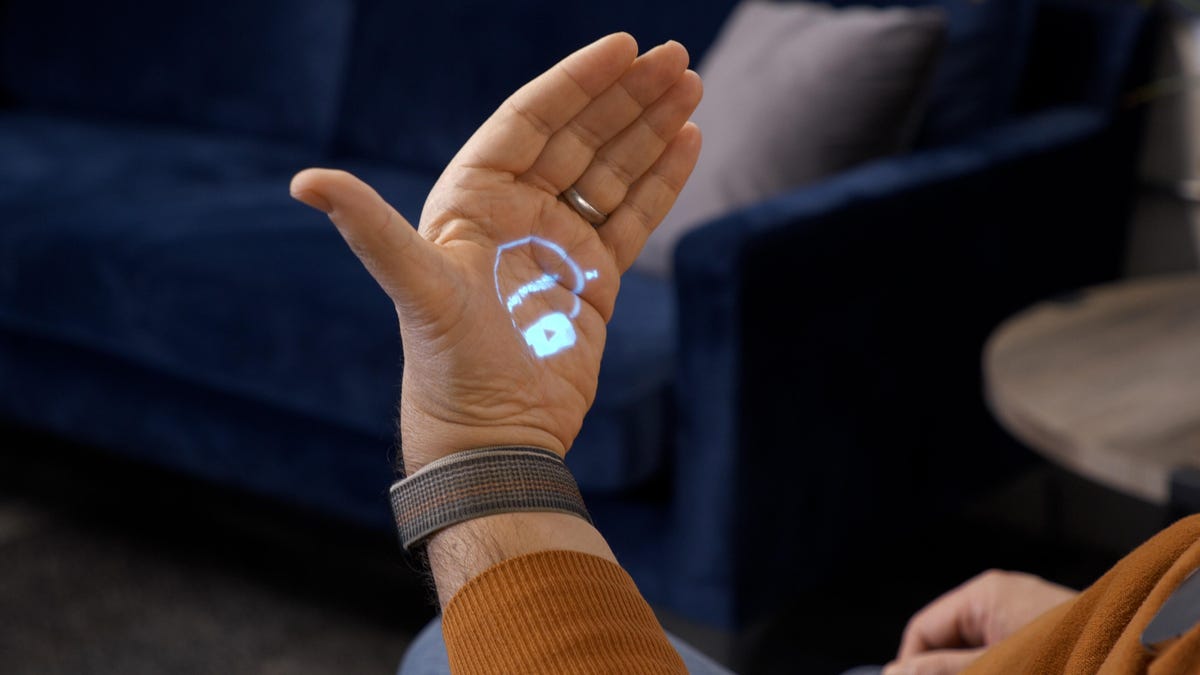
The AI Pin throws a laser display onto your hand, and hand gestures control the interface. Futuristic? Heck yes.
And if you want to connect to Wi-Fi, you need to navigate to settings with pinches and then dictate your Wi-Fi password, which isn’t easy. (You can also use a QR code, but that’s weird). There’s no other way to connect since there’s no phone app. As a frequent wearable tester, this baffles me.
Unfortunately, the laser display is nearly useless outdoors in normal sunlight; it washed out completely, and I had to shield my hand to even try to make out text. Even indoors, the projection can be hard to read on your hand because the text can bend and shift. Unlike a screen, your hand isn’t perfectly flat.
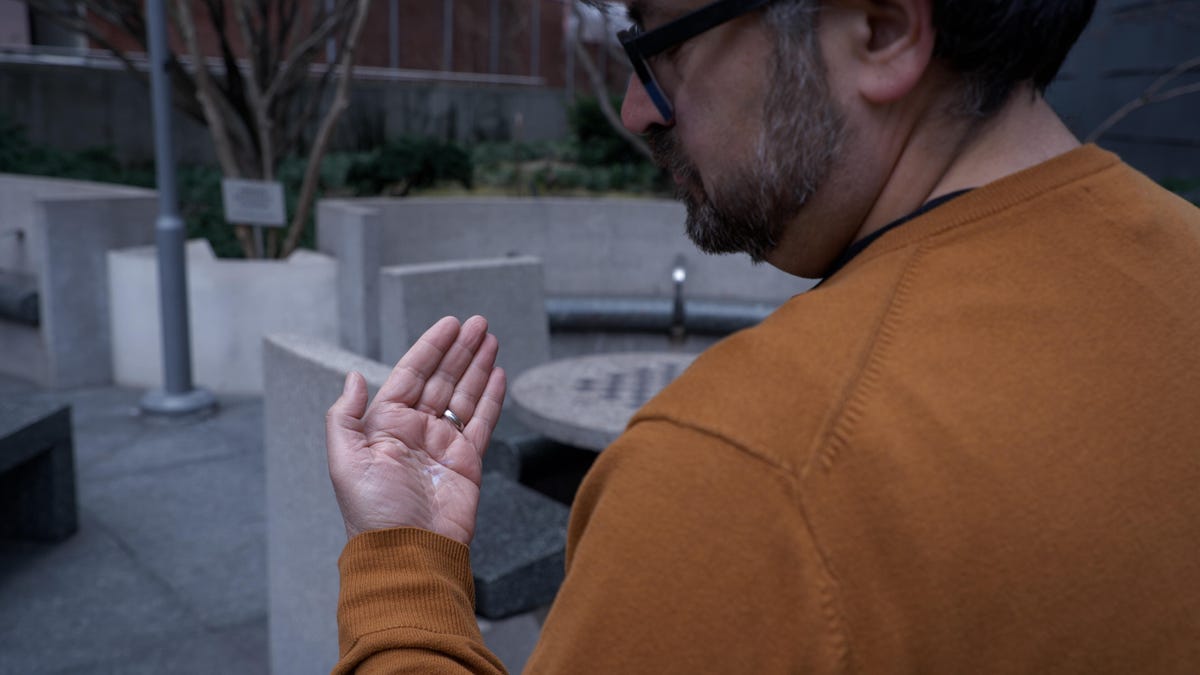
Mid-day in New York City, I can’t see the display on my hands at all in normal daylight.
Translation: Really cool, when it works
Tapping and holding with two fingers triggers instant translation, and whatever I say turns into Spanish the first time I try the pin. It works with 50 languages right now, according to Humane. It also automatically recognizes another speaker’s voice in the other language and translates it back into English for me.
Your phone can translate too, if you get the right app, but the AI Pin feels much closer to an instant magic translator. The problem is that my pin wouldn’t always switch languages. Sometimes it got stuck in German or French. Maybe this is an early issue, but it was certainly frustrating.
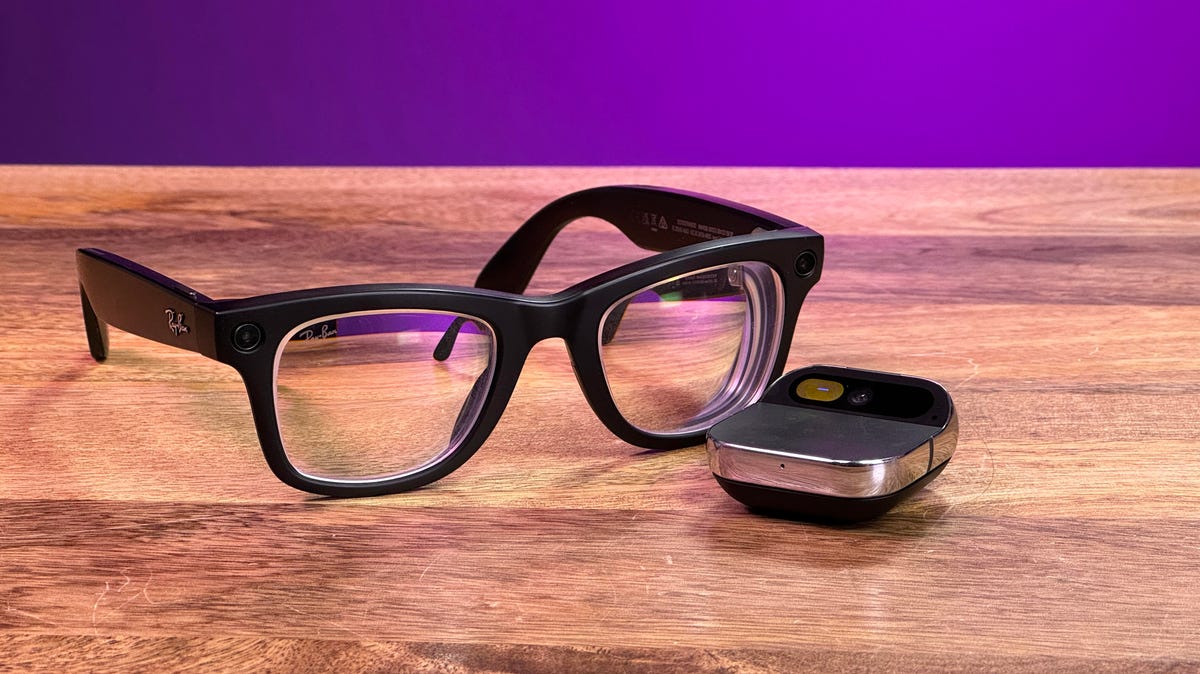
Much like Meta’s Ray-Ban glasses, the Humane AI Pin has a camera, and can use that camera to ping and analyze the world with AI.
A camera on the world, with some AI sight functions
Much like Meta’s AI-enabled glasses, the Human AI Pin can scan the world with its wide-angle camera to process and react to what you see. The results vary widely. I have to ask the device to “look” and then figure out what I want it to tell me, which feels like consulting a genie. Sometimes the answer is helpful and sometimes nothing much happens at all.
You can have the pin read things out loud, try to identify cars, plants or locations or describe a room. The relay between taking a photo and having the AI Pin answer back takes more than a few seconds. It’s a fascinating idea for a future world where seeing cameras we wear can be assistive tools; a thought I had when testing Meta’s Ray-Bans, as well. The process isn’t as automatic or as fluidly helpful as I’d want. Sometimes the AI just didn’t help me at all or gave differing answers to the same questions.

A photo taken with the Humane AI Pin, outside near the office. It’s fine, but I couldn’t always make out how to frame my shots.
The pin does take still shots using three snaps or 15-second videos. The camera quality is fine but not great. It’s also hard to predict what the pin’s photos will look like without a screen or viewfinder. You can preview shots in your hand but in blue monochrome. There’s something maybe fun about having a wearable camera that can just capture life moments without grabbing a phone, but overall I prefer Meta’s glasses for framing shots and what looks to me like better camera quality (but more to come on thoughts on how good the Humane AI camera can be). The limited video recording time means I’m not using it to save more than small snippets of real-time memories.

Some of the things I asked my AI Pin. It does have current news information.
Voice-controlled AI: Incomplete, unreliable
When I held up a can of Spindrift and asked the AI Pin to “look and tell me what this is,” the response was “‘Luck’ is a 2022 film distributed by Apple TV Plus about the story of Sam Greenfield, the unluckiest person in the world, who finds herself in the Land of Luck and must unite with magical creatures to turn her luck around.” I’m guessing it misunderstood me as saying “luck and tell me what this is.” That’s my life with voice-controlled AI, in a nutshell.
When the AI Pin’s AI works, it’s fun. I asked when the next train was coming to my town, and it knew. I asked who the New York Jets’ latest offseason move was for and then asked for the player’s stats. You can do these things on a phone, but services like Siri and Alexa don’t handle voice requests as smoothly all the time.
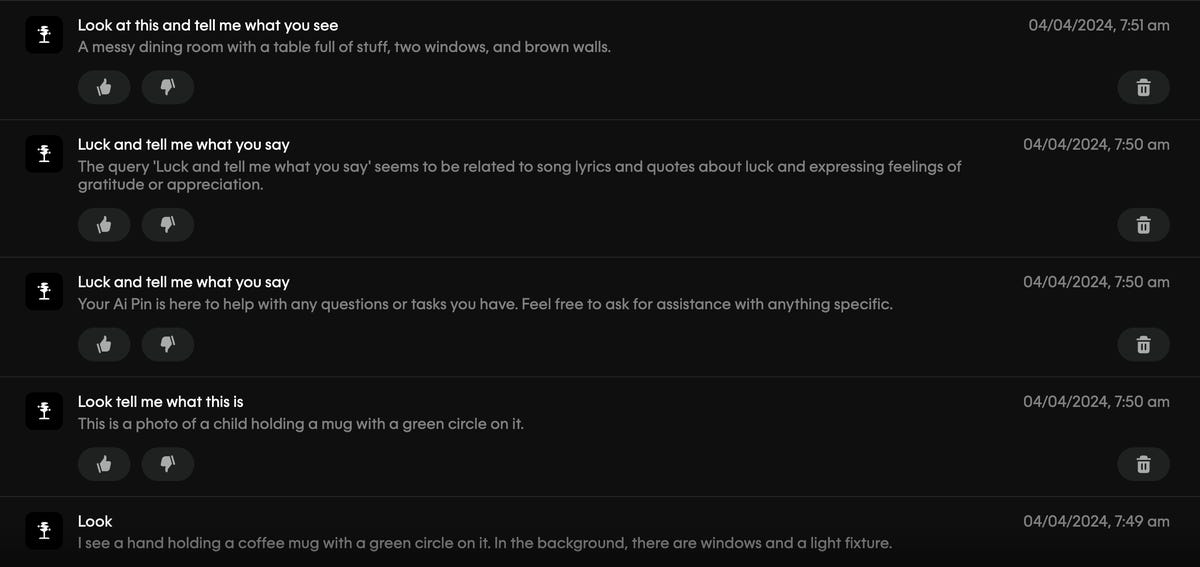
The AI Pin didn’t always understand me. This is common with voice-controlled AI.
The problem is that the generative AI assistant Humane AI gives me right now isn’t hooked into any of the services I use, and the answers are inconsistent.
The Humane AI Pin is disconnected from my world. As a self-contained, cellular-connected device, it doesn’t sync up with my phone at all. Instead of a phone app, the Humane AI Pin has a web dashboard where all my AI requests, photos and videos, and services are managed.
While I appreciate the ambition of what Humane is doing, it makes me feel like I’m starting my digital life all over again. It has no knowledge of my calendar, my emails, my notes or anything else. It can’t summon an Uber or look up my purchase history. That’s comforting, in a sense, but also points out how many services simply don’t integrate with it yet.
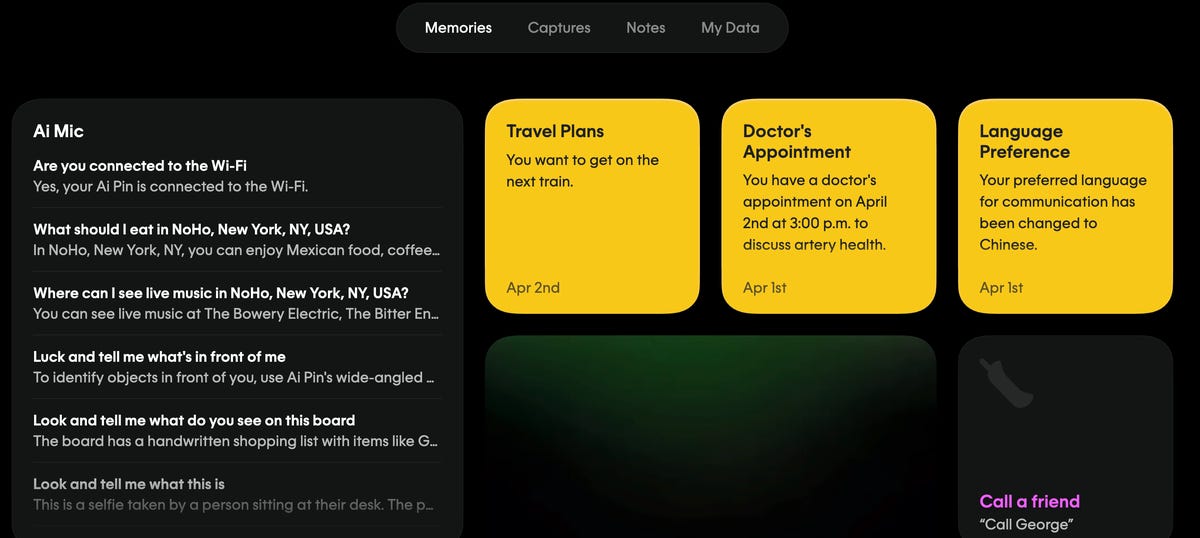
The web dashboard for Humane’s pin shows saved AI requests, synced photos and videos, and AI-recorded “memory” notes.
Humane’s web dashboard currently connects with Apple to sync contacts, Microsoft (also for contacts) and Google (contacts, and syncing to Google Photos). It supports only one music service: Tidal. If you happen to subscribe to Tidal, the AI Pin can play streaming music and the pin’s bluetooth-pairs with headphones.
More hook-ins are coming, according to Humane’s founders. It’s not even day one, at the time I’m writing this. Still, for a device that leans entirely on AI services to help me, I need those to work for the AI Pin to be useful.

There are a lot of things I couldn’t do yet.
I had plenty of moments where the pin told me it couldn’t do certain things yet. I couldn’t send an email. I couldn’t set a timer. I couldn’t check nutritional values. I couldn’t set a reminder. You can have the pin “remember” things, which get saved as notes in the Humane web dashboard. The pin will recall these later, like my kid’s names, for instance. I’d prefer it to import notes I already had stored elsewhere.
Another issue: Overheating
I found the AI Pin suddenly needed cooldowns whenever I used that laser display for more than a few minutes. An alert tells me the pin is overheated. When this happens, I can’t use the pin at all, which concerns me. First of all, what if I needed it? Second, I’m suddenly wearing a hot pin on my chest.
Humane’s founder, Bethany Bongiorno, said this is part of the pin’s thermal management. I’m hoping this issue gets addressed in updates because I wonder how this pin will handle everyday use if it’s already showing so many issues for me.

I started to get pretty frustrated with the AI Pin over the past week.
Unless it gets more useful and reliable, I don’t want to keep wearing it
I want to take off the AI Pin. It’s not as useful as my watch and not as fun as Meta’s glasses. It’s also in a strange new place that’s not as easy to wear, and I feel concerned about it when I’m outside. Will it fall off? Will rain damage it? (It’s not listed as being water resistant.) Will someone steal this expensive thing by grabbing it off my shirt?
These everyday moments of frustration keep mounting. But, these are early days for AI wearables. I’ll try the AI Pin on a trip I’m taking and keep checking for updates. It’s cute-looking and fascinating, and I love new tech, but I don’t love how difficult it currently is to use it.
If I want to live a distraction-free life without looking at my phone, I need ambient tech to operate smoothly. We all do. That’s not easy for the AI Pin, and so far, it needs to do a lot better.
Editors’ note: CNET used an AI engine to help create several dozen stories, which are labeled accordingly. The note you’re reading is attached to articles that deal substantively with the topic of AI but are created entirely by our expert editors and writers. For more, see our AI policy.

